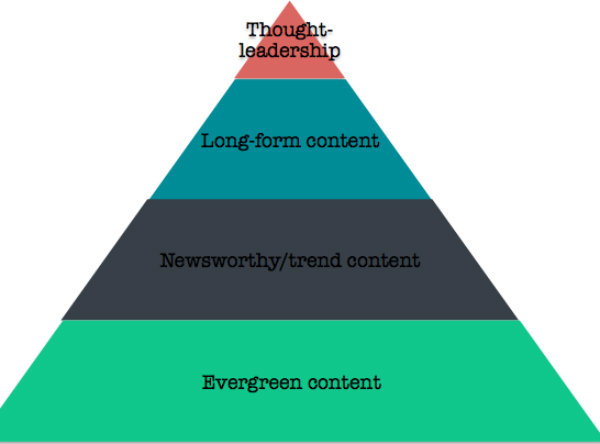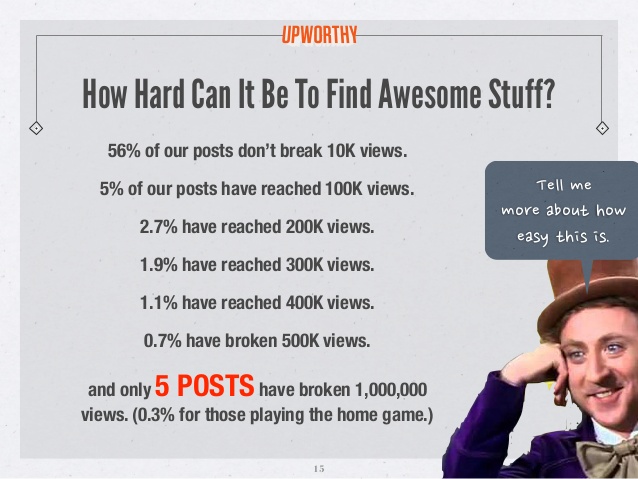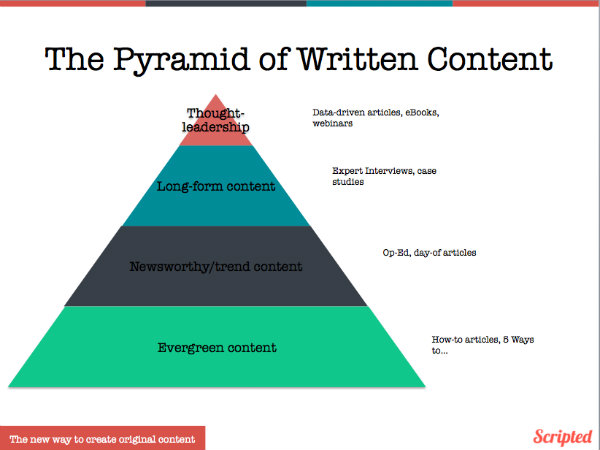- Blog Home
- Content Marketing
- Nicole Karlis
- The Pyramid Of Written Content: How To Present Your Story Ideas
The Pyramid of Written Content: How to Present Your Story Ideas
Deciding on how to execute your story ideas can be a difficult task.
In an ideal world, everyone would publish pieces of content with the highest likelihood of going viral day after day. However, the reality is even for those who have more pieces of content going viral than others, it's not happening as often as you think. As Upworthy revealed in a very insightful Slideshare presentation, about 56 percent of their articles barely break 10,000 views; 5 percent reach 100,000 views, and a small 0.7 percent have reached at least 500,000 views. Only five posts in total have reached over 1 million views; these are the ones they consider to be "playing the home game."
So while they appear to have articles going viral day after day, the reality is that isn't the case because creating content to go viral is realistically hard to do.
See also: How to Grow an Audience Through Content Creation
As you plan your content for next year you're probably thinking a lot about how you're going execute and create all of these amazing story ideas you have written down. This can usually be the most challenging step of your planning process. Producing high quality content everyday can be done, but that doesn't mean you have to publish one eBook a day.
Here we've come up with the pyramid of written content, in order of value priority (lowest at the bottom, highest at the top) to help put into perspective just how much of what you should create.
Let's break this down more specifically starting at the base.
Evergreen Content
This is the content that holds your blog together. While it might not be the content that goes viral everyday; it's very valuable for many reasons. First off, this is the content that readers are engaging with on a regular basis because it's easy to consume and it's answering the necessary questions. It can be presented as how-to articles, listicles, etc. This content can (and should be) be planned weeks in advance because it's untimely; it also should be a bulk of the content you create because it's easy to produce or outsource content. Additionally, publishing new content on a consistent basis will signal to Google that your website is a valid publisher. With the current changes to Google's algorithm, newer content will rank higher on search engine results pages because it is considered to be more relevant.
See also: How to Outsource Content & Maintain Your Brand's Voice
Newsworthy/Trend Content
Newsworthy/trend content is a layer up from evergreen content because it can't be planned in advance. These articles can be produced as day-of articles or opinion pieces on a current event happening in your industry. Newsworthy pieces of content are valuable because it helps show your readers that you're an authority in your specific industry. You can't gain credibility from your audience if you're not involved in the conversation that's happening within your network.
Long-form Content
Long-form articles, such as expert interviews or case studies, take more effort to produce, but typically have a higher return in your investment. From personal experience, we've seen higher engagement and more shares with our expert interview articles than we have with our day-to-day evergreen posts. These take more time to create, but will hold more value and information for your readers.
Thought-leadership Content
This type of content, such as eBooks or webinars, take the most time to prepare -- but ultimately will have the highest return in investment. This is because it's content that establishes you as an authority in your industry, contains highly valuable information, and can live in various places. For example, your eBook can be through search on Amazon or iTunes, but can be downloaded on your blog, and separated into various articles on your blog. This is typically the content you'll produce the least of due to time and resources.
As you can see, there are many different ways to produce and execute your story ideas, but ultimately the hard work will pay off.
How do you determine the best way to present your content? Share your stories with us in the comments section below.
Sign Up With Scripted Today
To Read More About Content Creation, See Below:
How Content Helped LearnVest Become a Trusted Authority in Financial Advice
How to Make Sure Your Content's Quality is Suitable for Google News
How to Use Twitter for Customer Service
Published by Nicole Karlis on Tuesday, December 3, 2013 in Content Marketing, Pyramid Written Content.


